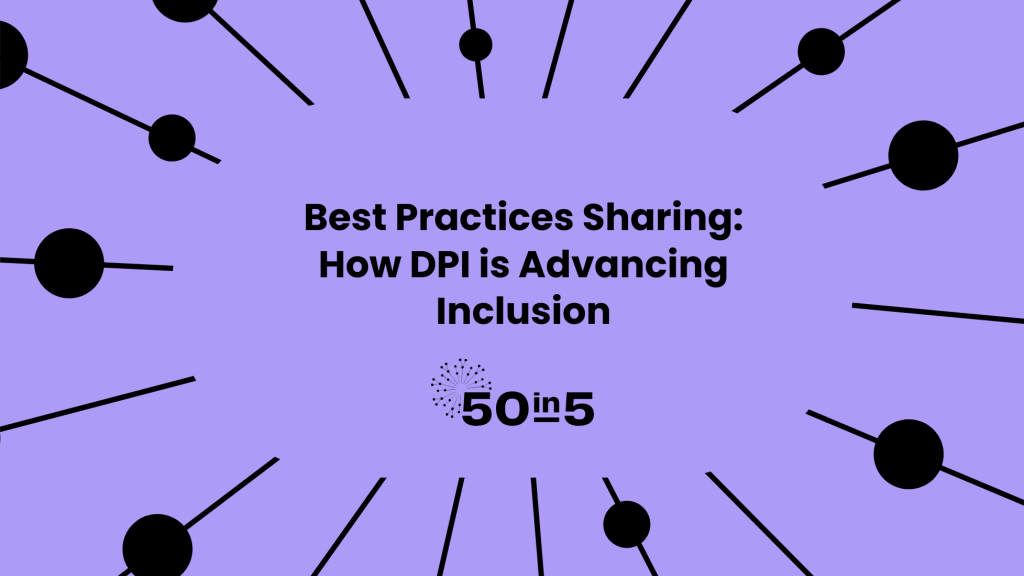Digital ID and Digital Payments for Advancing Inclusion

Authors: Aura Cifuentes, Director, Latin America & the Caribbean, Co-Develop, and Jon Lloyd, Director of Advocacy and 50-in-5 Program Director
As part of the 50-in-5 campaign, the Digital Public Goods Alliance (DPGA) and Co-Develop hosted a hands-on breakout session workshop during DPI Day at UN Open Source Week. Complementing the spirit of the campaign, this breakout session was designed to provide a dedicated platform for open dialogue, idea exchange, and the co-creation of concrete proposals aimed at embedding inclusion at different levels of digital public infrastructure (DPI) deployment. The session explored how open collaboration can accelerate the adoption of digital public goods (DPGs) and enhance DPI with a strong focus on ensuring equitable access to solutions, particularly in the areas of digital ID and digital payments.
The workshop highlighted the transformative potential of open-source solutions to drive interoperability, reduce costs, and promote inclusive digital transformation globally, celebrating successes and addressing key challenges. Featured speakers included Eng. Murenzi Daniel from the East Africa Community and Gabi Adotevi from MOSIP, both of whom support 50-in-5 countries with their digital implementations. In attendance were country representatives, DPG product owners, and those who support them from UN entities, civil society, and private sector companies.
This blog explores some of the key takeaways and learnings from the session:
- Inclusion as the starting point, NOT an afterthought: Both ID and payment systems must be co-created with the most marginalised communities in mind from day one. Designing for the “edge cases” first—such as those with low literacy, no connectivity, or disabilities—creates a more robust and equitable system for everyone.
- A multi-stakeholder, collaborative approach is crucial: Effective DPI cannot be built by governments or technologists in isolation. It requires continuous dialogue and co-creation between public sector bodies, private companies, civil society organisations, and end-users to navigate technical, ethical, and regulatory challenges.
- Open-source solutions, including DPGs, can be the core enabler: There was a commonly shared belief that leveraging digital public goods is an effective strategy for ensuring inclusion in DPI implementation. This approach reduces costs, prevents dependency on single private vendors (and vendor lock-in), allows for customisation to local contexts, and builds trust through transparency.
- Design solutions based on common technologies and in local languages: Reaching everyone means designing for the technology they already have. Inclusive payment systems must work on basic feature phones and not just on smartphones. Services should also be provided in local languages to ensure wider accessibility. This focus ensures that digital finance doesn’t become a privilege.
Insights on Building Inclusive Digital ID Systems
A successful Digital ID strategy should adopt a “digital first, not digital only” mindset—leveraging technology to accelerate progress, but never at the expense of inclusivity or accessibility. This means keeping multiple access channels open—such as in-person centres or assisted mobile options—so those without connectivity, devices, or digital skills aren’t excluded. It also requires designing with rural and marginalised communities in mind, allowing progressive onboarding, and pairing digital tools with trusted intermediaries. Above all, a Digital ID is a means to an end, not an end in itself. Efforts should avoid politicising the ID or treating it as the ultimate goal. The push for adoption must always be balanced with the protection of rights and freedoms; no individual should be excluded or have their civil liberties compromised in the name of scale or efficiency.
Other considerations included:
- Bring users upfront: Engage citizens from the beginning to build trust and relevance.
- Lead with a use case: A relatable, real-world example can help get communities and decision-makers excited.
- Understand local realities: Many rural communities haven’t used an ID in years—and some individuals don’t even have birth certificates.
- Don’t make Digital ID mandatory: It should not be a requirement to enjoy basic rights or access services, as that would risk excluding those without IDs (often the most vulnerable), eroding trust, and turning a tool meant for inclusion into a barrier.
- Protect marginalised groups: Ensure safeguards are in place so DPI doesn’t deepen exclusion.
- Go slow, accommodate differences: Adoption may need to happen gradually; forcing it can backfire and limit scalability.
- Communications must fit the context: A 100% digital strategy is often ineffective—combine digital and offline outreach.
- Incentivise smartly: Link IDs to tangible public benefits (e.g., Aadhaar and subsidies) to show value.
- Build awareness and transparency: Help people understand how and why their data is used. Citizens must know what data is collected and how it’s governed.
- Trust in government is key: Tailor strategies depending on whether you’re in a high-trust or low-trust environment.
Inclusive digital ID systems are within reach when countries put people at the centre, protect rights, and work together across sectors. By embracing openness and cooperation, Digital ID can become a powerful enabler of opportunity and trust—helping ensure that digital public infrastructure delivers for everyone, everywhere.
Be part of the conversation shaping digital cooperation worldwide—sign up now to receive updates and watch the DPI Cooperation in Motion 50-in-5 Milestone Event live, taking place in the context of the 80th United Nations General Assembly.
